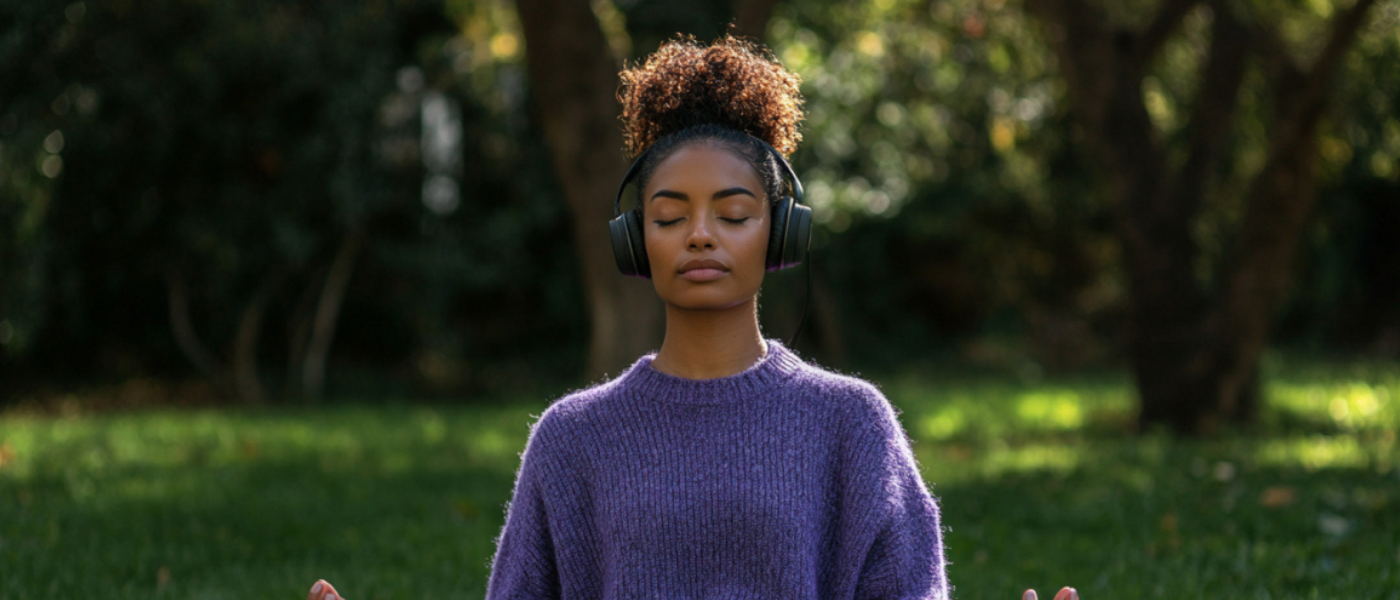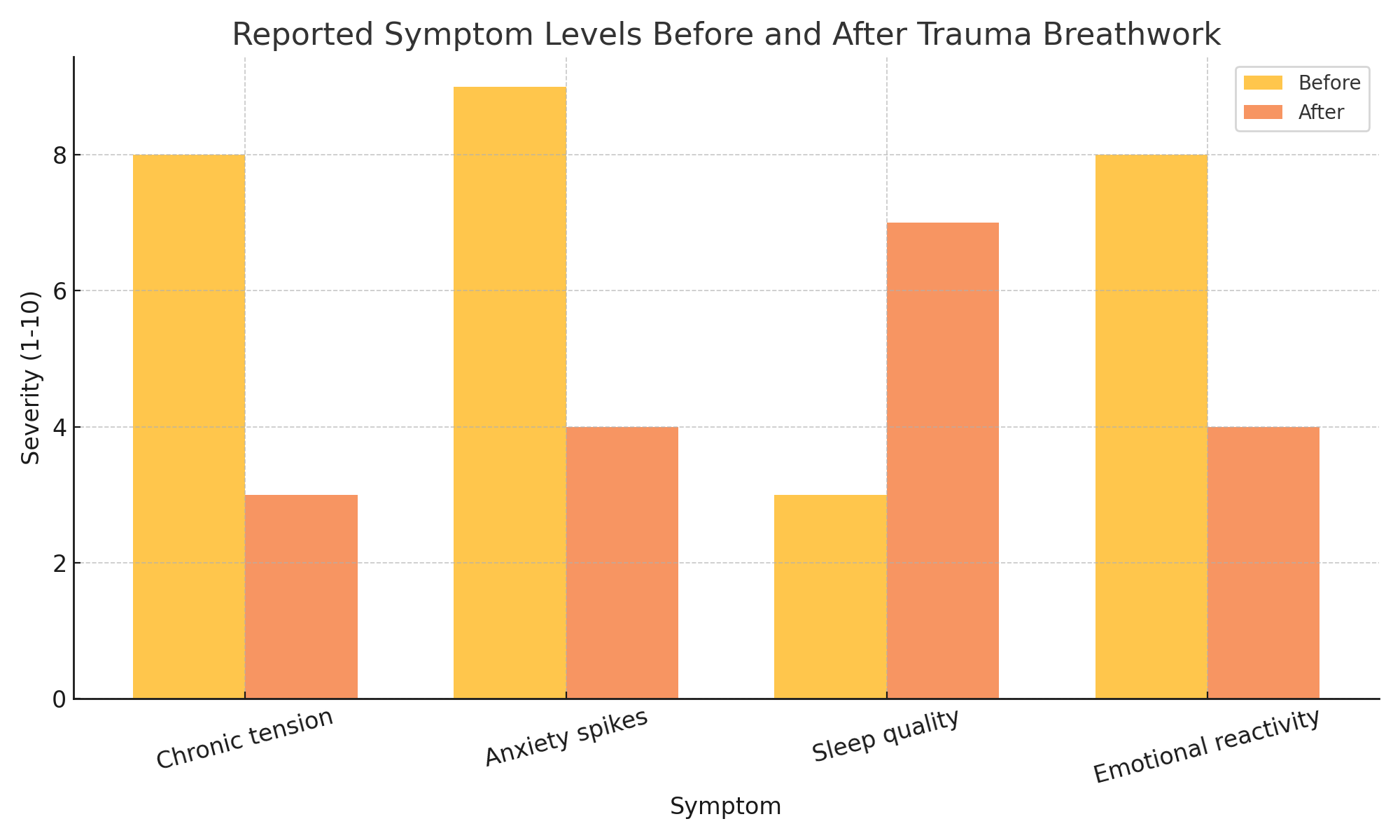Healing through trauma-informed Breathwork

What is trauma and trauma Breathwork?
Honestly, the first time I heard about “breathwork” as a way to heal and work through trauma, I was skeptical at best… “Breathing? Really? I mean, isn’t that something I already do every single day?” Turns out, there’s a huge difference between regular breathing and intentional, trauma-informed breathwork exercises aimed at healing trauma.
So, what exactly is trauma? There are many different definitions of trauma – Trauma is any event that overwhelmed our nervous system and our capacity to cope. When trauma is stored in the body, it is like trapped survival energy. It’s surprisingly common, yet many of us (myself included, initially) underestimate how deeply trauma can affect our mental health and physical well-being.
Trauma-Informed breathwork is a therapeutic practice that intentionally uses conscious breathing techniques to help process trauma stored within the body. The therapeutic benefits of conscious breathing for healing trauma are significant, as it helps us to integrate our past traumas so they no longer have such a tight grip on our lives.
At first, the idea of trauma being “stored” in my physical body seemed abstract. But after taking my first breathwork course 12 years ago, I quickly realised just how impactful breathwork is.
When practicing breathwork, you’re guided through specific breathing practices designed to bring more presence to your emotional landscape and to gently cultivate more capacity to hold your experience of being human.
Also Read>>> Best Breathwork Certification Online
To be honest, I found it challenging at first, to allow myself to truly feel the messiness and rawness of my own emotions – the things I’d stuffed down years before in the hope I could just ignore them and pretend they didn’t exist (as it turns out – that’s just not how our emotions work!)
Breathwork doesn’t magically erase trauma (trust me, nothing does), but it can genuinely help you process and integrate difficult experiences. For anyone skeptical (as I definitely was), all I can say is: don’t underestimate the simple power of intentional breathing.
Breathing techniques for trauma healing

So, let’s get into the specifics – because one of the questions I am often asked is, “How do I do breathwork?” Turns out, there’s not just one method. Honestly, at first, this can feel overwhelming. Multiple techniques? Couldn’t there just be one, easy option?
But here’s the thing: having options means you can find a method that genuinely resonates with you, rather than taking a ‘one size fits all’ approach (which is not very Trauma-Informed). Here are a few techniques I’ve explored, each offering unique experiences:
Related>>> 40 mn Free BREATHWORK MASTERCLASS
Holotropic Breathwork
Holotropic breathwork involves rapid, rhythmic breathing designed to shift your consciousness. Developed by Dr. Stanislav Grof, this technique aims to move individuals towards wholeness. At first glance (or first breath?), it sounded intense, and to be real, it is. Studies have shown that breathwork effectively alleviates PTSD symptoms in veterans.
Holotropic breathwork pairs quickened breathing with evocative music to induce a non-ordinary state of consciousness. During a session, don’t be surprised if tears start to flow and you notice a lot of deeply buried emotions rising up to be felty and expressed.
Functional breathing techniques
As simple as it sounds – learning how to breathe functionally is a game changer, and this is the basis of what we teach at The Whole Health Project.
The vast majority of people have poor functional breathing which, in turn impacts physical, mental and emotional health. Re-learning how to breathe functionally is the foundation for any other style of breathwork truly being effective and supportive and often involves a variety of simple breathwork techniques.
Wim Hof method
The Wim Hof Method became famous through “The Iceman,” Wim Hof. It involves deep, oxygen-rich breaths that change your heart rate and stress response. This isn’t for the faint of heart as it can quickly stir up a lot in the body and mind.
Also read>>> How to deal with uncertainty
Somatic Breathwork
Finally, Somatic breathwork is a therapeutic practice that combines conscious breathing with heightened body awareness to release stored tension and emotions. Many who practice breathwork recount profound emotional releases during sessions. It can help you to access deeper parts of the brain associated with safety and emotional processing, facilitating healing from trauma and stress.
There isn’t one perfect technique, you need to try different ones out and see how they make you feel in your own body.
The science behind trauma informed Breathwork

Trauma affects more than your thoughts—it lives in your body. When exposed to traumatic stress, the body activates the sympathetic nervous system (fight or flight), releasing stress hormones like cortisol and adrenaline. Over time, this dysregulates the nervous system and may contribute to chronic tension, anxiety, and even physical pain.
Breathwork interrupts this loop. By consciously adjusting your breath, you engage the parasympathetic system (“rest and digest”) and stimulate the vagus nerve. The vagus nerve connects your brain to your heart, lungs, and digestive organs, making it a powerful pathway for healing.
Studies have shown breathwork can reduce symptoms of PTSD, anxiety, and depression. According to the Journal of Traumatic Stress, aggressive breathing techniques can exacerbate trauma symptoms in individuals with stored trauma.. Also, biodynamic breathwork combines breath, movement, sound, touch, emotions, and meditation for trauma release.
Safety considerations for trauma Breathwork

Breathwork is on a spectrum – some practices can be very gentle – especially those that are aimed more towards resolving functional breathing, and some can be very intense. It’s essential to understand that some breathing techniques may not be suitable for everyone. Always consult a medical or mental health professional before beginning if you:
- Are pregnant
- Have a history of heart disease, epilepsy, or severe mental illness
- Have recently undergone surgery
Even emotionally, breathwork can open up powerful responses. Always work with a certified trauma-informed practitioner and ensure the space feels safe and supportive. It’s important to remember to honour how you feel in the moment and if it feels as though it is becoming too much, too fast or too intense for your body to process the practice, it’s important you stop. Remember – there is not one ‘right’ practice for everyone.
How Breathwork releases stored trauma

Emotional trauma isn’t only mental; it’s stored in the tissues of the body. This can show up as tightness in the chest, chronic fatigue, or unexplained physical symptoms. Breathwork can help loosen these stored emotions by creating space in the body and giving suppressed feelings a safe outlet.
For example, Trauma Release Exercises (TRE) trigger natural tremors that help the body discharge tension. In one of my first breathwork sessions, my legs began to shake involuntarily and I could feel a level of ‘release’ that I hadn’t let myself feel before.
It’s also important to note that not all trauma releases are dramatic. It might be that you simply allow yourself to cry for the first time in years.
Symptom changes before and after breathwork
Based on reported experiences and emerging clinical studies, individuals often notice tangible shifts in both physical and emotional symptoms after just a few breathwork sessions.
Many people report feelings of joy, resolution, and enlightenment after participating in breathwork sessions. Here’s a visualization of the most commonly cited changes:

Integrating Breathwork with therapy

Breathwork is not a standalone solution. Its strength lies in how it complements other therapies. After breathwork sessions, unresolved emotions may rise to the surface. Talking through them in therapy, processing them with a Somatic Practitioner or journaling can make the difference between catharsis and confusion.
You might consider these integration practices:
- Journaling immediately after a session
- Discussing emotional triggers with your therapist
- Tracking patterns in emotional or physical responses
Combining breathwork with somatic experiencing, EMDR, or traditional talk therapy often enhances the effectiveness of both approaches.
What to expect in your first 5 sessions
Breathwork is a progressive journey. While every individual’s experience is different, the timeline below reflects common emotional and physical patterns that emerge across multiple sessions:

Real stories, real impact

These are anonymised accounts shared by clients who have used breathwork as part of their healing journey.
- One client said “Breathwork seems to be changing my life and personality. Its given me a tool by which to calm myself and to focus.”
- Another said the practice helped her to unwinding from a decade filled with stress and trauma.
- A client who’d attended several sessions said “I feel like there is more space for my heart to open, I connect deeper with the people around me and it becomes easier each day to stay close to what my body needs”
These experiences differ, but the common thread is emotional release, regulation, and reconnection.
How to find a qualified Breathwork practitioner

Choosing the right guide is critical. Here’s a checklist to help you find a professional who aligns with trauma-informed care:
- Check for certifications from a trauma-informed training program.
- Ask about their experience with trauma-sensitive clients.
- Read reviews and testimonials.
- Make sure they ask about your physical and mental health before the session.
- Trust your instincts, if you don’t feel safe, it’s okay to look elsewhere.
You can start your search on directories like breathworkalliance.com or somaticpractitioners.org.
Overcoming common challenges in trauma Breathwork
Many people face resistance during breathwork. You might dissociate, question the process, or feel overwhelmed. This is normal and part of your system protecting itself.
Here’s what helps:
- Grounding techniques like pressing your feet into the floor or holding a soft object
- Knowing it’s okay to stop and take breaks
- Journaling afterward to process emotions
A good practitioner will guide you through this, remind you that healing doesn’t need to look any certain way, and provide reassurance when things feel intense.
Download the Breathwork readiness checklist
Before beginning your breathwork journey, it’s helpful to reflect on your readiness—emotionally, physically, and practically. This simple PDF checklist will help you self-assess and prepare for your sessions.
Download the Breathwork Readiness Checklist (PDF)
Conclusion: start where you are
Breathwork isn’t about perfection. It’s about reconnecting with your body and giving yourself space to feel again. Whether you’re at the beginning of your trauma healing journey or looking to deepen existing therapy, breathwork offers a powerful, accessible tool.
Take the first step when you’re ready. Research practitioners, read up on techniques, and most importantly, move at your own pace. Healing happens in layers, and breathwork is one compassionate way to peel those layers back – with safety, intention, and support.
If breathwork helped someone like me, once skeptical, emotionally armored, and cautious – it may help you too. And that’s a beginning worth breathing into.
FAQs
Not always. While breathwork is generally safe certain health conditions like pregnancy, high blood pressure, heart or cardiovascular disease,, epilepsy or recent surgeries might pose risks. Always consult a healthcare provider or qualified practitioner first.
Everyone’s experience varies. Some people (myself included) feel immediate relief after one session while others experience gradual changes over multiple sessions. Healing is personal so be patient and compassionate with your process.
It’s actually normal! Breathwork often brings up deep emotions. A skilled trauma-informed practitioner will guide you through those emotions creating a safe space for release. Remember it’s okay to pause or stop anytime.
Initially working with a qualified practitioner is highly recommended especially when dealing with trauma. Once you’re experienced and comfortable you can safely integrate simpler breathing exercises into your daily routine.
No, breathwork is most powerful when combined with other healing modalities like talk therapy or somatic experiencing. Think of breathwork as a powerful complement—not a complete replacement—for traditional therapeutic approaches.





This article truly spoke to me. As someone who’s been navigating deep emotional healing, discovering trauma-informed breathwork has been a game-changer.
I appreciate how clearly this piece explained both the science and the soul behind the practice. It’s rare to find content that feels so grounded and accessible, while also honoring the deeper layers of healing.
Thank you for shining a light on such an empowering and compassionate approach to wellness. Bookmarking this to share with a few friends on their own healing journeys.
Alyssia, thank you so much for your beautiful words. We’re deeply touched to hear how this piece resonated with your healing journey. It’s exactly why we do what we do—to create space for grounded, soulful wellness content that truly supports people where they are. Knowing it spoke to both the science and the spirit of breathwork means the world. And thank you for sharing it forward—this is how the healing ripple grows. Grateful to have you in the YOGI TIMES community.
Namaste,
JC
Coming from both personal experience and working with clients, this really hit home. Trauma-informed breathwork has been one of the most supportive tools I’ve seen when it comes to nervous system healing—but it’s not talked about enough in a grounded, accessible way like this. I’ve read a lot on the topic, and honestly, this piece just felt more real.
The way you wove in the importance of safety and pacing in breathwork—it just, makes sense. This kind of healing work takes time, and this article actually respects that. Grateful you put this out there.
Thank you so much for your thoughtful reflection. It truly means a lot—especially coming from someone who’s both lived and supported others through this kind of healing work. We deeply believe in honoring the pace and nuance that trauma-informed practices require, and it’s incredibly affirming to hear that came through in this piece. Safety, accessibility, and realness are at the heart of what we aim to share. Grateful to be in this conversation with you—and thank you for the work you’re doing in the world.
With appreciation,
JC
Publisher, YOGI TIMES
This article really resonated with me. I’ve been on a healing journey for a while now, and trauma-informed breathwork has been one of the few tools that’s actually helped me reconnect with my body and calm my nervous system. The way you explained the connection between trauma and breath was so clear and relatable.
I think more people need to know how breathwork can support emotional healing, especially when it’s approached in a safe, informed way. I honestly didn’t expect to feel so seen reading this—but I did. Thanks for sharing from such a grounded place.
Thank you so much for taking the time to share this. Your words truly mean a lot. We’re committed to offering content that supports real, embodied healing—and hearing that this piece helped you feel seen is exactly why we do what we do. Breathwork, when held with intention and care, can be such a powerful ally in reconnecting with the body and creating space for emotional healing. We’re honored to walk this path with readers like you. Please keep sharing your voice—it makes this community what it is.
Warmly,
JC
Publisher
Really appreciate this article—it brought together things I’ve been feeling but hadn’t quite found the words for. Trauma-informed breathwork has been a huge part of my emotional release process over the last year, but it’s hard to find writing that actually respects how delicate and layered that kind of healing is.
This piece did that. The way you described the connection between breath and nervous system support—it just felt honest and real. Not every breathwork practice is safe for trauma, and more people need to understand why that matters.
Thank you for offering something that felt both informed and deeply compassionate.
Thank you so much for sharing this—your words truly mean a lot. We’re committed to honoring the depth and complexity of healing work, especially when it comes to practices like trauma-informed breathwork. It’s incredibly validating to hear that this piece resonated in a way that felt both honest and safe. We believe the conversation around nervous system support and emotional release needs to be handled with care, and it’s readers like you who help us keep this space grounded and real. So grateful you’re part of this community.
With gratitude,
JC Gabler
Publisher, YOGI TIMES
I’ve been exploring trauma-informed breathwork for a few months now, and honestly—this article just hit different. Most of what I’ve found online either gets too clinical or kinda skips over the emotional side of things.
But this actually spoke to what it feels like to reconnect with the body and support your nervous system in a real way.
The part about pacing and somatic release especially resonated. Healing takes time, and not every method out there really respects that, ya know? Just wanted to say thanks for putting this together—it felt thoughtful and real.
Thank you so much for this, truly. It’s incredibly affirming to hear that the article landed with you in such an honest way. We care deeply about making sure the content not only informs—but feels human, accessible, and rooted in real experience.
Trauma-informed breathwork is such a nuanced practice, and you’re absolutely right: the pacing, the emotional depth, the nervous system support—it all matters. We’re grateful to be walking alongside readers like you who bring both curiosity and lived wisdom to the conversation.
it’s not always pretty but breathwork brings out stuff u need to face. and somehow you feel better after.
don’t get how something so simple (just breathing??) could bring up so much. but here we are. crying and healing lol.
more ppl should know about trauma-informed breathwork. wish i found this sooner fr.
been holding onto grief for a while. after one guided session, i actually slept through the night. breathwork therapy is underrated.
it’s like i finally exhaled after holding my breath for 10 years. this is deep healing work.
i’ve tried so many things for anxiety. this is the first thing that helped me stay grounded without feeling overwhelmed.
breathwork that’s trauma-aware >>> regular breathwork. makes a huge diff when the facilitator knows how to hold space.
wasn’t expecting to feel that much emotion in my chest. it just bubbled up. this is real trauma healing.
body was in survival mode for years. this type of breathwork helped me feel safe again. powerful stuff.
lowkey this is helping more than meds ever did. not saying stop taking meds but like, this + that = 💯
ngl i thought breathwork was just hype… but this trauma-focused approach helped me calm my nervous system like nothing else has.
🫁 this trauma-informed breathing practice got me feeling feelings i didn’t even know i buried. def gonna do this regularly.
been doin yoga forever but breathwork is on another level. it’s like therapy without the words.
still don’t really understand how it works, but i’ve done a few of these sessions and each one helped unlock something inside. it’s real healing.
man… one session and i felt lighter. like emotionally, not physically lol. breathwork healing is no joke.
i tried this after my therapist suggested it. honestly felt more in tune with my body in 15 mins than in months of talk therapy.
I love how the article emphasizes the importance of community and shared experiences in the healing process.
This piece has inspired me to explore trauma-informed breathwork as a means to deepen my self-awareness and healing journey.
The connection between breathwork and emotional regulation is profound, offering a tangible tool for managing stress and anxiety.
I appreciate how the article normalizes the challenges that can arise during the healing process, encouraging readers to be gentle with themselves.
The mention of working with a qualified facilitator underscores the importance of guidance and support in trauma-informed practices.
This article serves as a gentle reminder that healing is a journey, and breathwork can be a supportive companion along the way.
The emphasis on the body’s innate wisdom and its ability to heal through conscious breath is empowering.
I love how the article highlights the importance of integrating breathwork practices into everyday life for lasting transformation.
The discussion on how breathwork can help process subconscious patterns is enlightening and offers hope for those seeking healing.
This piece has encouraged me to approach my own healing with more curiosity and less judgment.
I appreciate the inclusion of various breathwork techniques, providing readers with tools to explore and find what resonates with them.
The article’s focus on the non-linear nature of healing is refreshing and reminds us to honor our unique journeys.
It’s inspiring to see how trauma-informed breathwork can empower individuals to reconnect with their bodies and emotions in a safe and supportive way.
Awesome
Totally feel you Stephanie1981 – breathwork has legit changed the way I process old stuff. I didn’t even realize how much I was holding on to until I tryed some of the trauma-informed techniques. Like, wow, it’s a game-changer
The mention of integrating breathwork into daily routines offers practical advice for those looking to incorporate healing practices into their lives.
I love how the article emphasizes the importance of self-compassion and patience in the healing process.
The article’s insight into how breathwork can release stored tension in the body resonates with my own experiences of finding relief through mindful breathing.
This piece has deepened my understanding of trauma-informed breathwork and its potential to foster resilience and self-awareness.
The connection between breath and the nervous system is profound. It’s enlightening to learn how conscious breathing can help regulate emotional responses.
I appreciate the emphasis on creating a safe space for breathwork practice, allowing individuals to explore their healing journey at their own pace.
This article beautifully highlights how breathwork can serve as a gentle yet powerful tool for trauma healing.
not all breathwork is trauma-aware, so this kinda work is 🔥. finally felt safe to explore my stuff.
just wow. breathwork hit me hard. thought it’d be chill but ended up crying halfway in. didn’t even know i needed to release that.
this trauma-informed breathwork isn’t just about breathing; it’s about listening to your body and giving it space to heal
wasn’t sure about breathwork, but after trying it, i felt a release i didn’t know i needed. it’s like my body finally exhaled.
never knew breathing could be so powerful. after a few sessions, i felt more grounded and present. highly recommend giving it a shot
been through some stuff, and this trauma-informed breathwork gave me tools to process it. it’s not a quick fix, but it’s a start.
thought i was fine, but breathwork showed me how much i was suppressing. it’s not easy, but it’s real healing.
didn’t realize how much i was holding onto until i started breathwork. it’s like my body was telling me stories i didn’t know i needed to hear.